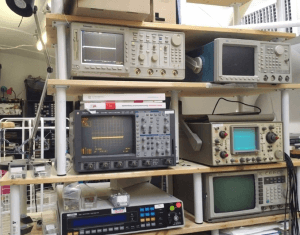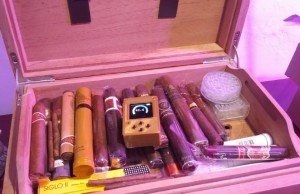The 8-Bit Microcontroller and Beyond: An Interview with Tam Hanna
Electronics and Cigars
Elektor: Ok, so we've covered the 8-bit microcontroller. Now let’s shift to your background and interests. When did you first become interested in electronics? Were you inspired by someone? Or perhaps you developed your love for electronics by tinkering on your own?Hanna: In the 1990s and 2000s, people interested in technology were automatically branded Internet-addicted sociopaths. Professionalizing my interest in electronics and IT was a way to escape. Microcontrollers and PDAs don’t care much about who operates them. As long as the source code or the circuit configuration is valid, the system works. This merit-based system came as a welcome escape for me, and has kept me happily and profitably at work ever since.

I taught myself a lot of stuff experimenting on my own. This, however, should not disgrace the TGM engineering school in Vienna. Having had access to the workshop was a huge nuisance at the time, but in retrospect, I saw so many things which I would not have seen in another way.
It would be unfair and bad character if I would not thank all the people who have joined me on my engineering journey — whether it was buying apps for PDAs, mobile phone applications, books or my many, many consulting clients. Thank you to all of you. Thanks also to all the people who wrote books, allowing me to learn from them. And, last but not least, thank you for reading this interview and for contemplating to purchase my book. I would be humbled if my text helps you in achieving your goals.
Elektor: Tell us about your current work.
Hanna: OK, this will be a long one. One of the great things in the life of this electrical engineer is that it just never gets boring. There is just so much going on.
The interview is being made in a somewhat funny time. The firm currently is voluntarily quarantined, as are most of our suppliers. This is not so bad though. I recently traded my facility for a large underground lab in Hungary. I’m sitting there, working on all kinds of engineering projects. Before I dive into some specifics, let me point you to my Instagram account. Always stay on top of what the Crazy Electronics lab is up to by following my Instagram.
Thanks to stockpiling, my company is able to continue working as normally. The focus is aimed at supplying our clients with engineering consulting work to keep their processes running. In addition to the new products discussed below, I use this opportunity to do some maintenance tasks. I am thinking about recapping my Solartron tabletop multimeter, fixing clogged 3-D printer extruder heads, doing interior renovations, and installing new kitchen fixings. Finally, I might also clean up the laboratory floor so that my wife can finally get around to mopping it.
Elektor: Do you have any engineering tips or advice for Elektor readers?
Hanna: On the risk of making myself enemies and inviting my ex-wife to say that my lab looks like it’s located in Havana, Cuba, do not hesitate to buy used things. Having your own vector network analyzer or your own spectrum analyzer is worth its weight in gold. Trust me that your lending place will be closed when you need the kit the most.
In addition to that, I can’t stop repeating the old advice to try and break tasks down into smaller problem units. Taking it one step by step, in many cases, is more efficient. Finally, as said in my book, do not be afraid to switch between the hardware and the software domain. And do not hesitate to abuse systems to debug themselves. One really good example for this approach was the debugging of a Kinect application. It was intended to split a picture across threads in a piecemeal fashion. So, thread one handled the left-most part, thread two the middle, and thread three the right-most part. We solved the problem by temporarily making each thread paint each pixel which it touched. After running the modified code, it became clear that the thread picture boundaries were not correct – fixing this, then, was a piece of cake.
Finally, do not hesitate to play with “big machines” and mechanical work. My property was a catastrophe when I took it over, and now is in a more than decent state. The experiences I gathered in mechanical tasks ranging from assembling and adapting furniture to fitting vents on Circo-Geyser radiators directly translate to my electrical engineering work.
Elektor: Engineers and makers understand the importance of learning from their mistakes. What was most instructive engineering-related mistake you’ve made?
Hanna: This will sound stupid. Normally, I advocate for pushing forward. But my stupidest mistake in recent history was trying to go solo on a TDS754D attenuator repair even though I obviously could not do it due to a tremor at the time. Asking for help or passing off a task to a colleague can, in many cases, save you time and money.

Another mistake involves not religiously gaffa-taping hard-to-replace parts of equipment to the carcass during repair. I recently spent a week looking for a small brass cover for a 576 – without it, the fuse for the mains could not be installed.
Finally, always be willing to go where no one has stood before. Using 3D printing in consumer-facing applications was, so far, considered insane. I am pretty confident that owners of Humidors will, soon, appreciate being able to pick the color of their Hygrometer.
Elektor: What’s next for you? Do you have a new book, product, or project in the works?
Hanna: Next for me? I’ll go and light up a cigar. And while doing that, I will look at one of my upcoming products — the HygroSage. It is the first Humidor hygrometer which does not need calibration at all, has a color screen, and has a 2% accuracy guaranteed over lifetime.

New product number two is the Stinkely series of replacement displays. Danaher makes a pretty penny selling cathode ray tubes for the Tektronix 57x series of curve tracers – we will, soon, throw a wrench into that piece of mechanics. Plus, rescuing these units from the landfill always gives me a warm and fuzzy feeling.
Finally, I work for a US-based fashion start-up which still is in stealth mode for legal reasons. (The USPTO is a strange and fascinating place.) But trust me if I say that we will redefine sunglasses and ashtrays – if you currently circle a $200 (US) ashtray or a $200 (US) set of sunglasses, better wait and let us surprise you.
Are you working on a project featuring an 8-bit microcontroller? You can share details and collaborate with other engineers and makers with a free Elektor Labs account. Sign up today!
Read full article
Hide full article


Discussion (1 comment)